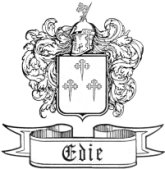Arriving in New Zealand
John Edie arrived in New Zealand in November 1862 with a team of horses to carry the much needed supplies to the Dunstan. John’s services in carting supplies would have eased a major problem for the new field - hunger.
It is probably fortuitous that John was not among the first wagons of supplies to reach the Dunstan diggings. When J. Sinclair was on his way with a load of flour he was met by Sergeant Ryan who conducted him to Watson Shennan’s station where flour was rationed out at 3lb per man at 2/6 per lb. These precautions were taken to prevent any repetition of a previous occasion when hungry miners had intercepted the waggoner and doled out the precious flour under their own terms.
Further insights into the lives of waggoners are provided by Betty Veitch. She cites their fuel on the journey from Central to Dunedin as being Buffalo chips (dried dung), Yellow pine (straw) or Kaladdies (flax flowers and stem). The tracks were in a dreadful state of ruts and mud, and the danger of overturning was great. Small groups of waggoners used to travel together (no doubt for general support and help). They used to camp together and socialize. A favourite camping site was on the Earnscleugh side of the river where the Clyde bridge crossed the river.
John decided to try his hand at goldmining again. He first mined at Switzers in 1863. Colin Robertson described the early town of Switzers as having a magistrate and warden, police and a lock-up. The post office was in stores, and then in the schoolmaster’s residence. It had doctors and a hospital with a matron. A surprisingly well structured society for one so much a frontier! He goes on to describe it further:
"When I first went to Switzers there used to be a mail twice a week carried on horseback from Mataura. In 1869 the road was put through from Beaumont (in Central Otago) to Switzers and there used to be a coach running several times a week."
This was a wealthy field: from 1871 to 1875 it averaged 9400 oz, a steady yield. It was, however, not lucrative enough for John and his ambitions. He went to Waitahuna and bought a share in the Long Race Sluicing Co. Evidence of his commitment to this new country is his willingness to return to Bendigo, and have his wife and three children settle in New Zealand. Their passage too was to be paid, so some means for this had been earned on the fields.
They left Melbourne in the ship Aldinga, and arrived early in June 1863. I wonder what John and Mary thought of this new society. I should imagine that they stayed in a hotel before proceeding to Waitahuna the next day.
Whether Mary lived in a tent in Waitahuna when she first arrived on the fields, I don’t know; however I hope not, as the Otago winters are cold. It would have been a welcome reunion with Mary’s sister Margaret, who had been bonded to the Rev. Will until October 1862 in Taieri. It was through her association with the Edies that she met her husband, William Duff. They were married in 1865. "It is said that after the wedding, Margaret asked William where they were going to live. ‘Oh - by Jove, I never thought of that’ was the reply; however he took steps to remedy the situation." They bought the Derby Inn in Waitahuna from John Oxenbould, and they lived there for the next 25 years.
In this new land the family of John and Mary continued to grow, for in addition to the three Australian-born (John, Edward and Janet), Thomas was born in 1864, Mary-Anne in 1869, George in 1871, and Elizabeth, Robert, and Albert followed, their last child being born in 1881.
There were further family members to join Mary at Waitahuna. George and Edward (Ned) Shepherd, with their mother Janet (nee Barry or Barrie) emigrated to New Zealand. George never moved from Waitahuna gully. He was employed as a raceman and lived in a little hut along the Gully Road. He was remembered for his conversion to the Salvation Army cause. He married a woman called Kate, and had three children who died young. Kate survived George for 20 years, and was known as Aunt Kate.
Edward became an apprentice carpenter at Tapanui and for many years carried on his trade in partnership with Ted Strong who married his second daughter, Edie. Edward provided a home for Mrs. Shepherd senior in her later years until her death in 1896.
Waitahuna may have been a new frontier but, it must have become an example of the extended Scots family, providing support, social events and a sense of belonging that was not the case with many immigrants then. In one story, however, they show Mrs. Shepherd snr. living up to the stereotype of the hard-working, unsentimental Scotswoman. The story relates to her death. Margaret and Mary took turns sitting with her. "Get on with your work", she said angrily, "I’m only dying." After that they had to creep in on their hands and knees to prevent her from knowing they were there.
She was buried at Tapanui cemetery, far from the Scotland of her birth, but having seen her children settled in a new land, far from the mines of Cowdenbeath and free from slavery to the mine bosses.
They were there.
